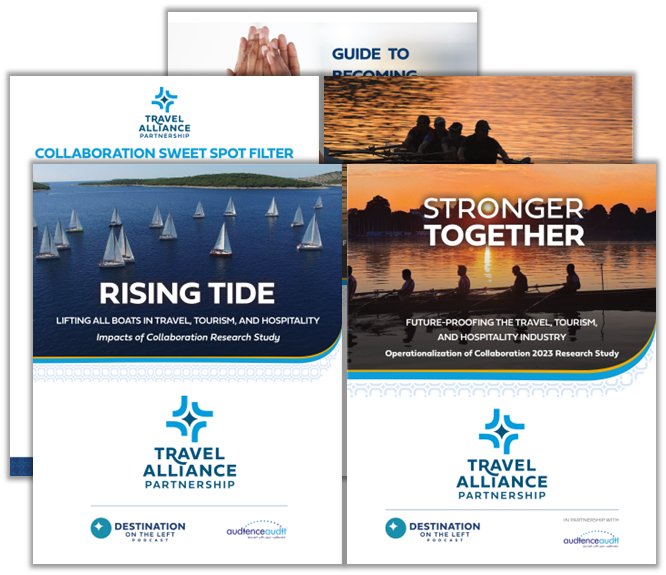Food for Thought: Inspirational Food Writing Tips for Destination Marketing
“I love how food has a magical power of bringing people closer together and breaking down barriers.”– Michelle Ng, episode 297, Destination on the Left
Inspiration to travel can be sparked by alluring restaurant destinations. Since meals are a big part of any trip, writing about food in a way that inspires is key to destination marketing.
According to Food Travel Monitor, 53% of leisure travelers are food travelers. Research shows that food travelers want to learn about local culinary cultures and customs. They love storytelling and history and travel near and far to find authentic food and beverage products and experiences.
As a former food writer for a local newspaper, I’ve learned that the food on the plate is just one piece of the multi-sensory restaurant experience puzzle. To create a well-rounded and enticing write-up on a food asset, it’s important to get personal and take visitors behind-the-scenes.
Below is a breakdown of eight elements that can add personality, depth and ultimately curiosity to your destination’s culinary stories.
Inspiration Behind the Menu
Take readers beyond the cuisine “type” with a deeper dive behind what makes the chef tick with their menu development. From family recipes (secret spices in grandma’s Sunday sauce), to unique ingredients discovered abroad, to a chef’s love of foraging. These types of examples can provide a more personal connection and appreciation to the menu offerings.
One-of-a-Kind Dishes and Plating
Call out the restaurant’s most unique dishes that travelers can find only at that location. From playful and over-the-top presentations, to dishes that are organic, rustic or sophisticated works of art – describe the specific ingredients, preparation and plating styles in order to intrigue and offer excitement for the venue.
Seasonality and Local Collaborations
Highlighting seasonal offerings on the menu helps create urgency for diners, as dishes are only available for a limited time. When appropriate, tie in the area’s other assets that partner with the restaurant – from distilleries and wineries to fruit farms and bakeries. Fresh is best and those that support local get a bonus!
Hear from Brian Mastrosimone in episode 180, the owner of Lincoln Hill Farms on Canandaigua Lake, in the Finger Lakes Region of New York. He explains their collaboration with neighbor Star Cider for a dinner on his site’s sunflower fields.
Are you taking the time to ask questions about area partnerships or out-of-the box collaborations?
The Chef’s Story
Every chef has their own path that led them into the kitchen. Are they self-taught, or did they fall in love with food while studying in another country? Ask them about their mentors, the moment they knew they belonged in the kitchen and their favorite part of the craft. This is an opportunity to translate the passion behind the plate.
On episode 251 with Karolina Guilcapi, owner of boutique travel company Sated Ventures, explains that coming face-to-face with people to hear their stories has always been her goal. Therefore, she incorporates chefs as guides in her tours. They go to local markets, talk about the ingredients and specialties in their culinary scene and take the group to their home or restaurant to enjoy a beautiful meal together. According to Karolina, sharing stories takes you to a different level of a relationship – that’s the special memories that you’re going to bring home. What inspiring content that experience would make across social platforms, blogs or website testimonials!
The Owner’s Journey
Discover what brought the restaurant owner into the business. For many, it’s in their blood and they’ve grown up in the kitchen. For others, it’s a second career – once a dream and now a reality. Many owners are the heartbeat of the business, greeting customers, knowing their favorite dish and forming friendships that span family generations. They are often the ones who add that “extra touch” to the dining experience that brings customers back for more.
Location and Décor
Uncover details behind the restaurant’s location and atmosphere. Did the owner always want to be in a specific city, or does the building have historical references? What’s special about the décor? I’ve discovered personal travel artifacts, identified the importance and significance of photos on the walls, and even some owners who were the craftsman to build the location’s furniture. These extra facts and features add character and distinction.
What the Regulars Have to Say
Seek out loyal customers and find out what keeps them returning. Talking to the diners can give the reader a different and personal perspective to the restaurant. What stands out in their minds as special, may come as a surprise to staff members, as they are viewing the experience through a different lens.
Taste Test (my favorite part!)
Make the time to taste and experience the location for yourself. This is a time to be adventurous and try preparations you may not typically explore – you may be pleasantly surprised! It’s also important to sample from various courses – from cocktails and appetizers to desserts and in-between. Focus on the textures, scents, tastes and colors. Not only is it a time to tickle your taste buds, but it will bring your key learnings full circle and help your food writing be more descriptive, exciting and authentic.
Author
Related Posts
How Curated Experiences Can Help Your Tourism Marketing
In years past, travelers may have been satisfied to see sites like the Eiffel Tower or Colosseum; now they want to get behind the scenes,...
Marketing for Group Travel: Building Solid Relationships with Tour Operators
Group travel is a significant segment of the tourism market, and if you want to see those buses pulling up to the curb and filling…

